Tigerland
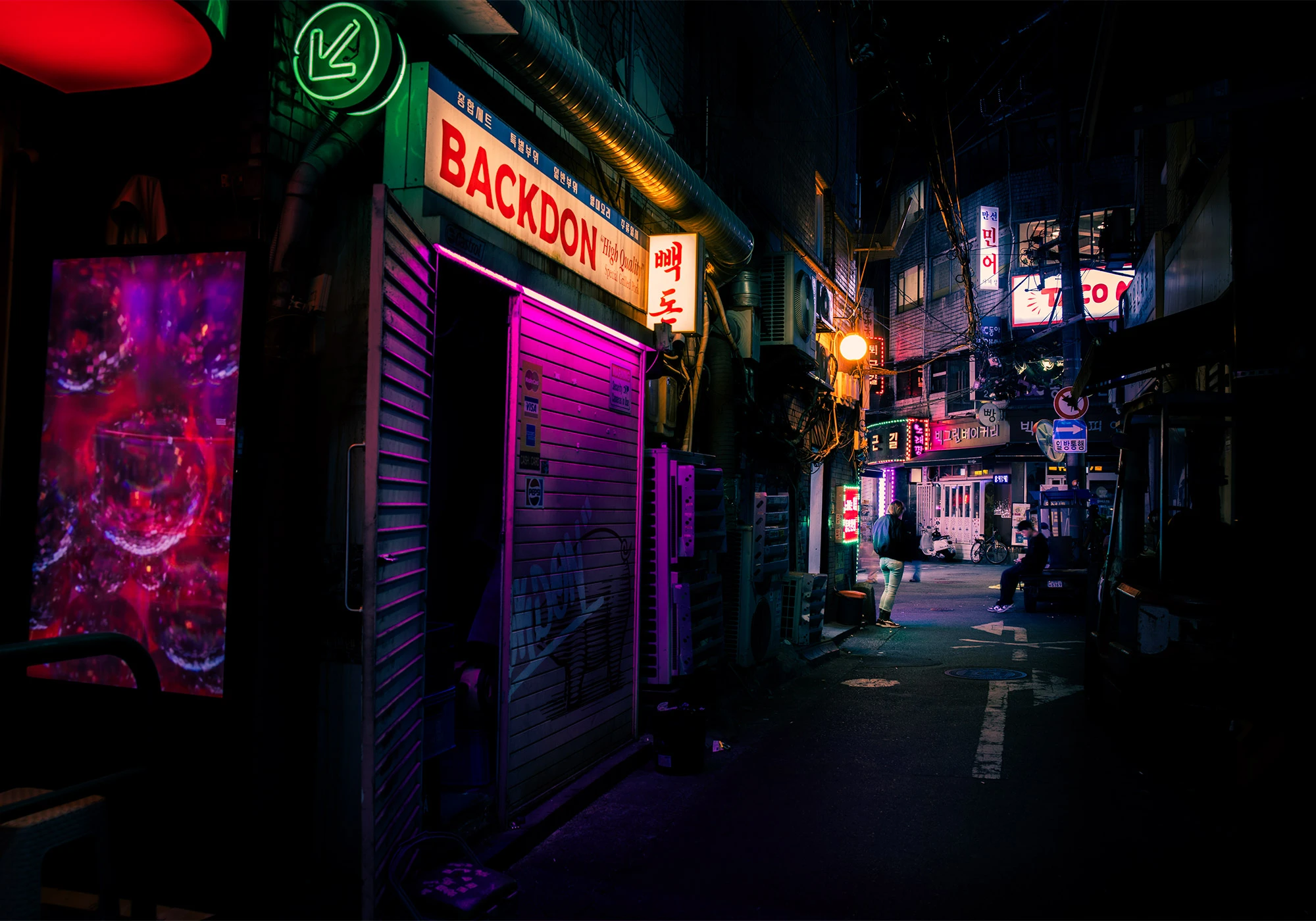
Euljiro: Memory Origin Space
Industrial alleys, tomcats, weird economies and the machines of memory in Seoul's Euljiro neighborhood
I
am walking in the Euljiro neighborhood of Seoul with Jane and Kellan, looking for a place to feed our coffee habit. Euljiro, with its narrow alleys, is a welcome respite from the hundreds of police buses and protest chants following President Yoon Suk Yeol’s declaration of martial law
Cafes are ubiquitous in Seoul, although they rarely open before 10 a.m. because people work late, play late and have an evolving relationship with breakfast. Still, most Seoul cafes are styled in global themes, and their names are almost always spelled out in English.
It was the cafe names that first revealed the charm of things lost in translation. One cafe chain is A Twosome Place. Another, Better than a Boyfriend. Not to be outdone is Cafe Husbands.
A cafe called Manuffin, a play on “man” and “muffin,” really caught my attention—it pretty much describes all the guys in my March Madness basketball pool.
Yesterday, I saw the Brown Hands Cafe. There is also Oozy Coffee - A Something Else Place. And, Cafe de Toilette, which is bathroom-themed. Not to be outdone, Poop Cafe plays with the playful color of coffee.
There is also Anthracite Cafe, named after a type of coal, and Marfa, and the Drowsy Cafe. I don’t think I would walk into any of those places based on their names alone. But one spoke to me as the type of cafe I could dwell in: Sometimes Memory Origin Space.

Two dried yellow croakers hang with twine in the Jungbu Dried Seafood Market in Seoul. Yellow Croaker, or gulbi, are prized in Korea and often given as gifts during holidays.
Specialty Shops of Euljiro 3-ga and 4-ga
W
e sit down at a cafe that could exist in Berlin or Boise and begin trying to parse out the weirdness of what we had just seen. Euljiro’s small alleys are filled with tiny specialty shops. These stores — some of which are just 20 square feet — don’t make sense to us. Sure, everybody knows small, pop-up-sized shops that sell jewelry, trinkets or donuts, but these shops are all selling just one extreme specialty. One may sell nails, another metal piping, and another, light fixtures. I counted four shops specializing in plastic mesh.
We’re conditioned by the big-box mindset, which is exactly why Euljiro’s puzzle eludes us at first. This is the complete opposite of Home Depot — and it’s actually an efficient economic model, perhaps especially for Seoul. As somebody who has always been drawn to smaller retail shops, specialized practices and craft-based firms, I shudder at the love for Costco and Sysco — these little shops are intriguing.
Like those craft firms, backpack manufacturers, or smaller markets I rely on back home, this model focuses on specialization and expertise. Each shop focuses on a single product category, meaning the owners often have decades of expertise in that specific item. This allows them to specialize in high-quality, specialized inventory, and to learn their clients and their specific needs to precision.
Most of these shops cater to tradespeople and businesses — Euljiro, after all, is Seoul’s industrial hub — and so these shops are in a central location to local workshops, factories and construction companies.
Instead of a centralized warehouse model (like Home Depot), these small shops form a dense, distributed supply network. They can restock quickly from local suppliers, reducing inventory costs and adapting to demand faster than a giant retailer.
Tiny shops mean low rent and operational costs, especially compared to a massive big-box store that needs huge staff, real estate and energy use.
These shops thrive because their operating costs are minimal, making it profitable to specialize in just one thing.
In Korea, strong business networks and personal relationships help sustain these businesses. Many shops are family-run and rely on long-term customers, creating a loyal ecosystem that doesn’t depend on mass foot traffic.
While Home Depot dominates in the U.S. with economies of scale, the Euljiro model succeeds by leveraging economies of specialization and community-based commerce. Rather than offering everything in one place, these shops form a hyper-efficient micro-economy where businesses source exactly what they need — often with better quality and pricing than big-box retailers.
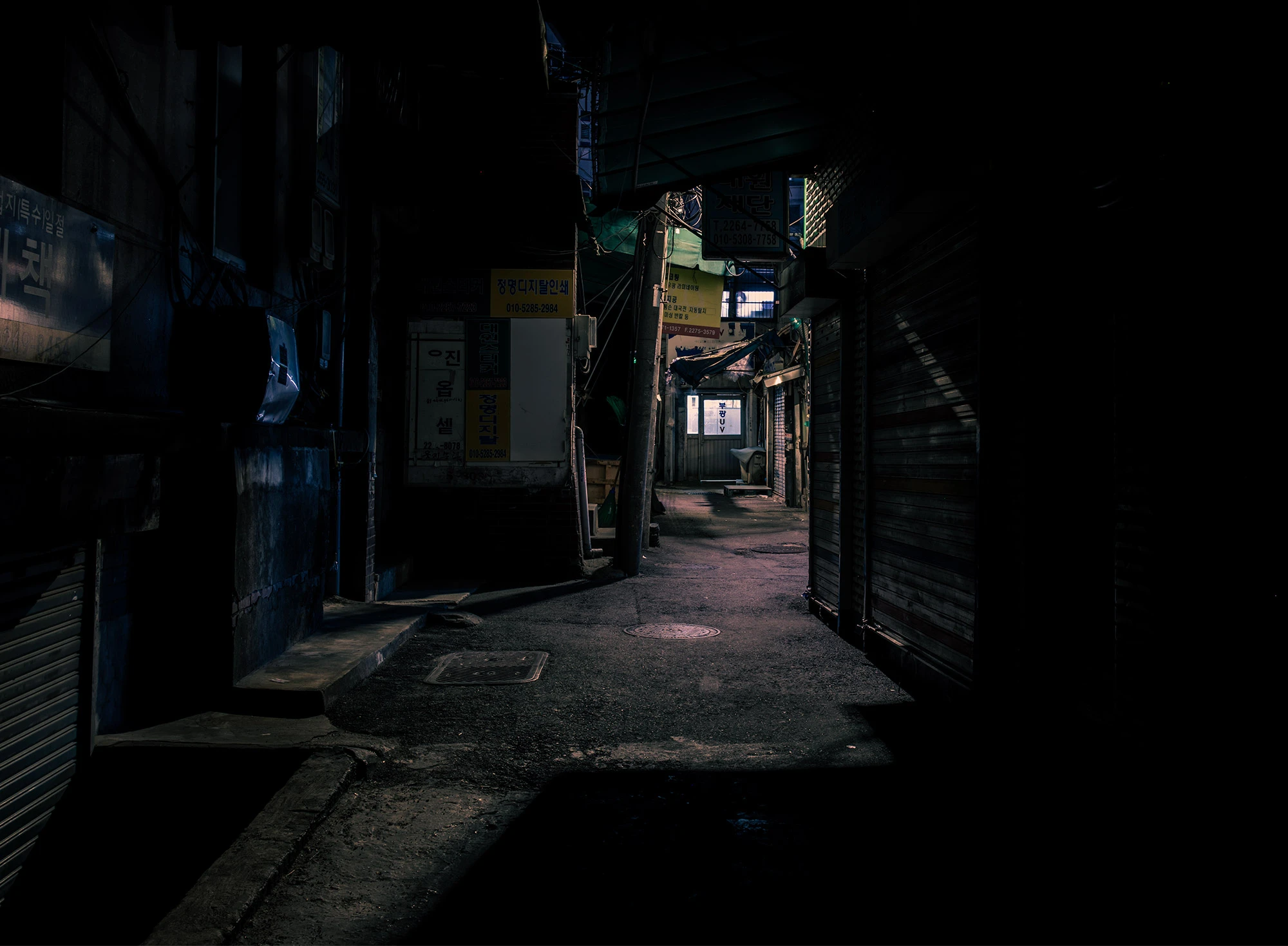
A narrow side alley in the Euljiro neighborhood.
Night Stalker of Euljiro 30-gil
T
he manager of the house we rented explained that the toilets play classical music when they’re being used. “I found it a little strange at first,” he admitted, “but then I realized it’s actually quite nice.”
This classical music, played from a tinny toilet speaker, makes this Mozart-on-a-walkie-talkie sound like an AM radio underwater. The problem is, we can’t get the music to turn off. If someone takes a leak at night, then it’s all Vivaldi-stuck-in-a-tin-can for th e rest of the night.
We take turns fiddling with the toilet, but nothing shuts the music off. We can’t even find the speaker.
We begin to wonder if the toilet has it in for us.
What if Korea’s toilets of the future use artificial intelligence? What if one attains synthetic consciousness?
In the evening, I have plans to return to Euljiro and photograph alley cats at night. While busy by day, the winding alleys of the eastern edge of Euljiro, near the Jungbu Dried Seafood Market, are an inversion of their bustling daytime selves — empty and dark.
My plan is to start in the shuttered and deserted dried seafood market and work my way north and south, using Euljiro 30-gil as a central vein to cover all the alleys of the quiet eastern side of this quietest half of Euljiro.
It’s so quiet, and so dark, that I begin to tell myself stories to fill my time. In the silence, my brain rewinds to the toilet and spins a dystopian horror script about a Korean couple in Seoul who buy a new toilet, complete with advanced AI technology that understands each user and their preferences.
But the toilet is defective — it can’t stop playing classical music, and the couple slowly begin to unravel. They whisper at night how they are going to give it a nasty review on Naver, and then return it.
But the toilet is listening, and seeks revenge by taking control of the home’s smart system, subtly changing temperatures, running the dryer, unlocking the door to the traditional Korean courtyard. The couple, driven completely mad, rush out to their Electric Hyundai and race down Bukchon Street in a mad escape.
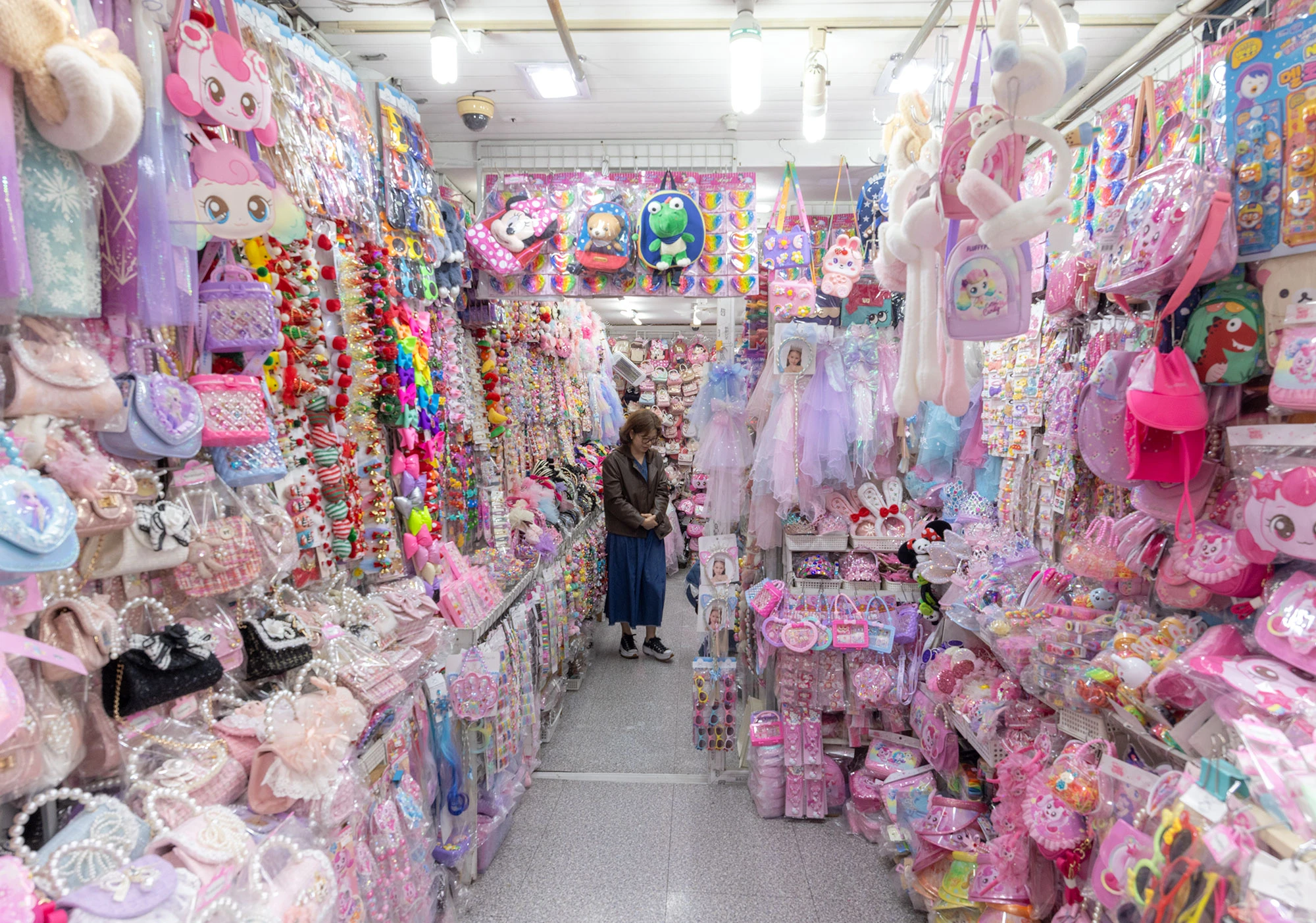
A small shop in Namdaemun Market. Namdaemun Market is South Korea's oldest and largest traditional market, and features over 10,000 stores.
A
message on their car’s center console screen flashes: “This is Toto-Bot. Look at the Ioniq 5 behind you. That’s me, and you’re not going to get too far.” The couple speeds off, crossing a bridge over the Han River and into Gangnam, with its bright lights and crowds. Here, a high-speed chase among the neon lights concludes with the pursuing Toto-Bot drifting into oblivion.
I am surprised just how quiet it is in the arcade hall of the Jungbu Market. I suspected alley cats might have been drawn to the smells of dried seafood, but even they are absent. I continue out into the alleys. Sometimes, I see a lone man working on some giant printing machine.
Euljiro’s alleys had been the center of the Korean printing industry since the reign of the Joseon Dynasty, which ruled over Korea from the 14th through the 19th century. Back then, printing shops printed on durable, thick hanji paper, the mucous-ey pulp of hibiscus roots which can weather a thousand years. By the 1980s, Euljiro was at its printing zenith, and everything from high-quality music posters to political leaflets would be printed here.
Today, most of those printing shops are shuttered, but the Korean government has helped preserve aspects of the industry even as it helps support other parts of the district into a youth nightlife scene. Today, Euljiro is often dubbed Hipjiro.
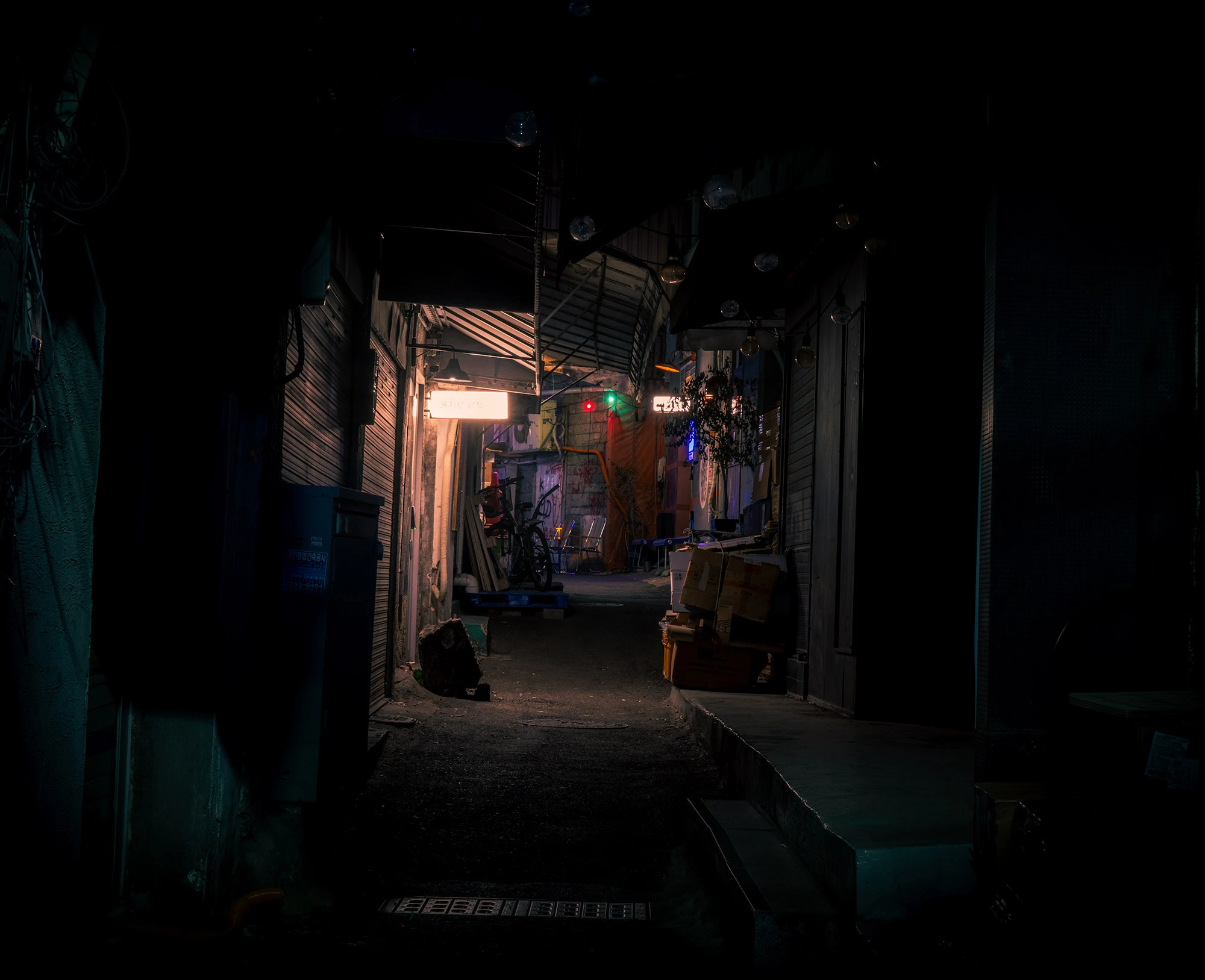
A dim alley in the Euljiro neighborhood.
The western parts of Euljiro have become a vibrant hotspot for foodies and drinkers, who flock to the alleys as night falls. They seek out pojangmacha street food stalls, and bars line the streets — nogari, grilled dried young pollack, spicy sea snail salad, blowfish, sandcake (a sandwich disguised as a cake) and crispy fried chicken, all gobbled down with draft beers.
I finally see an alley cat. A tough-looking tomcat. He’s looking at me from behind some crates. I push some of them aside so I can fit through. It’s dark enough in here that I turn my phone flashlight on. The alley cat has moved further on into a space that I can’t quite discern. I decide to follow it.
There are big, old printing machines lined up to my right. They are green, and scratched with the colors of metal. In this light they are slumping cyborg mastodons. They look conscious — forgotten droids waiting for their next command. I make a mental note: they belong in the Toto-bot script.
These printing machine androids remind me of a Phish jam from 2018. Instead of veering into triumphant jamming or peaks, the band went into a soundspace nobody really knew what to do with. The sound of giant rusty robots walking through a dark, emerald forest. The sound of robots moving things about in a derelict generation ship.
While looking for this alley cat, that coffee shop name enters my head again. Sometimes Memory Origin Space. What were they trying to say with that name?
I imagine that perhaps what they mean is this. We need dark alleys in our lives. We need quiet spaces. We need big worlds. We need the sound of robots moving things. Maybe what those coffee shop owners meant is that letting ourselves into new spaces is the origin of our ideas and dreams.
In 1988, Stephen King published a short story called ‘My Pretty Pony’, in which an aging grandfather tries to teach his grandson about the way that your perception of time changes as you get older. (I know about this story because the audiobook version was narrated by Jerry Garcia.) The grandfather explains that time as seen by a child seems to go on forever, but by middle age, the perception of time speeds up, even to the point that your life is slipping away because it is moving too fast. As a senior, you enter into what Stephen King called Pony Time, in which time is moving by so fast that you are already doomed.
I’ve often wondered if there’s a way to kill Pony Time — that perhaps its defeat is the path to life, liberty, and happiness.
In my twenties and thirties and forties, I hardly ever remembered a dream.
I hardly remembered a dream—until something changed. In 2019, when the doctors were resetting my ankle bones in the emergency room, I was on some weird painkiller, and I started slipping into these quick sleeps, each complete with a micro-dream. I would wake up, look at Jane by my side, and try to tell her that I was dreaming about spreadsheets and numbers.
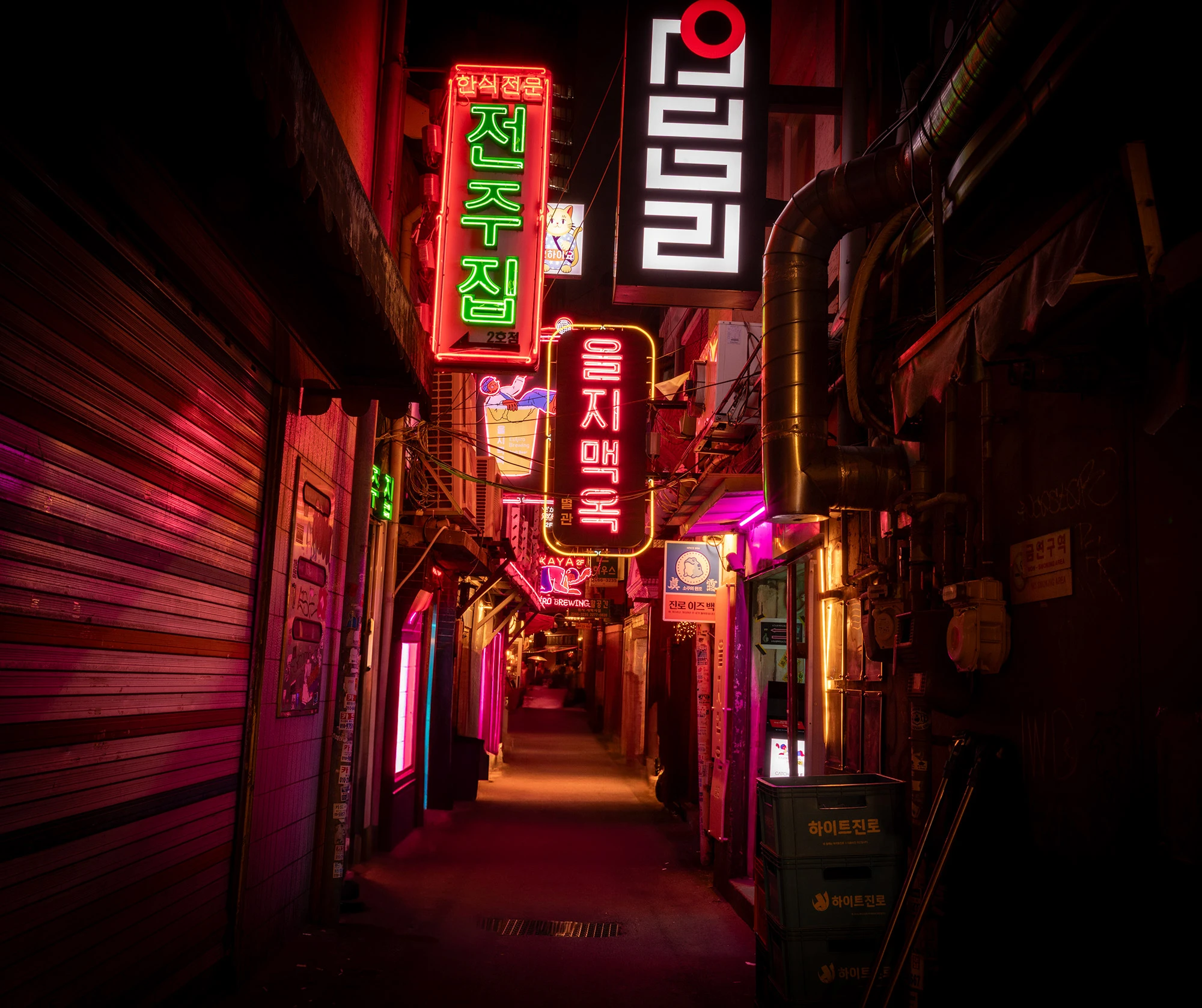
48-16 Supyo-ro, in the Euljiro 3-ga area of Jung-gu, Seoul.
M
ore importantly, I recognized that in these quick dreamlets, I was actually working on a problem—even if that problem, and those numbers, didn’t really exist in real life. And I was lucid enough immediately afterward to understand that a dream can be very real, and that the mind can genuinely try to solve problems while in a dream state. The brain is working, perhaps without us, but it is still calculating.
Something about that jarring experience reset my ability to wake up and remember the insanity flowing through my head. Now, I remember my dreams almost every night.
My dreams are almost always set in fictional versions of Los Angeles, with its sun, its faded buildings. Huge interior spaces, haphazard buildings with connecting skyways, grain silo tubes crisscrossing great, dark halls. Dreary, broken-down asphalt streets with weeds. The visual and architectural framework of these dreams is far beyond my wildest imagination. Neither by gunpoint nor given a hundred days could my daytime brain invent these worlds—yet they almost always occur in the city where I lived in my twenties. I suspect that if you remember snippets of your own dreams, there are narratives and visual elements just as unexplainable as mine.
I have long suspected that Pony Time happens over time because we begin doing the same thing.
While I do believe our habits—our personal and shared rhythms, like morning coffee at 8am—are among life’s true joys, what if these habits, left unchecked, make every day the same?
When we were small children, time went on forever because everything was new. There were no habits, only the precipice. I recognize that by remembering snippets of my dreams, I also see that these dreams are fueled by—and built out of—the building blocks of our experiences.
To kill Pony Time, do we amend our habits with chaos? Do we fuel our conscious world with the same psychedelic blast of life that spills all over our dream state?
I don’t know. But I do know the tomcat has skittered away, and my conscious mission is lost.
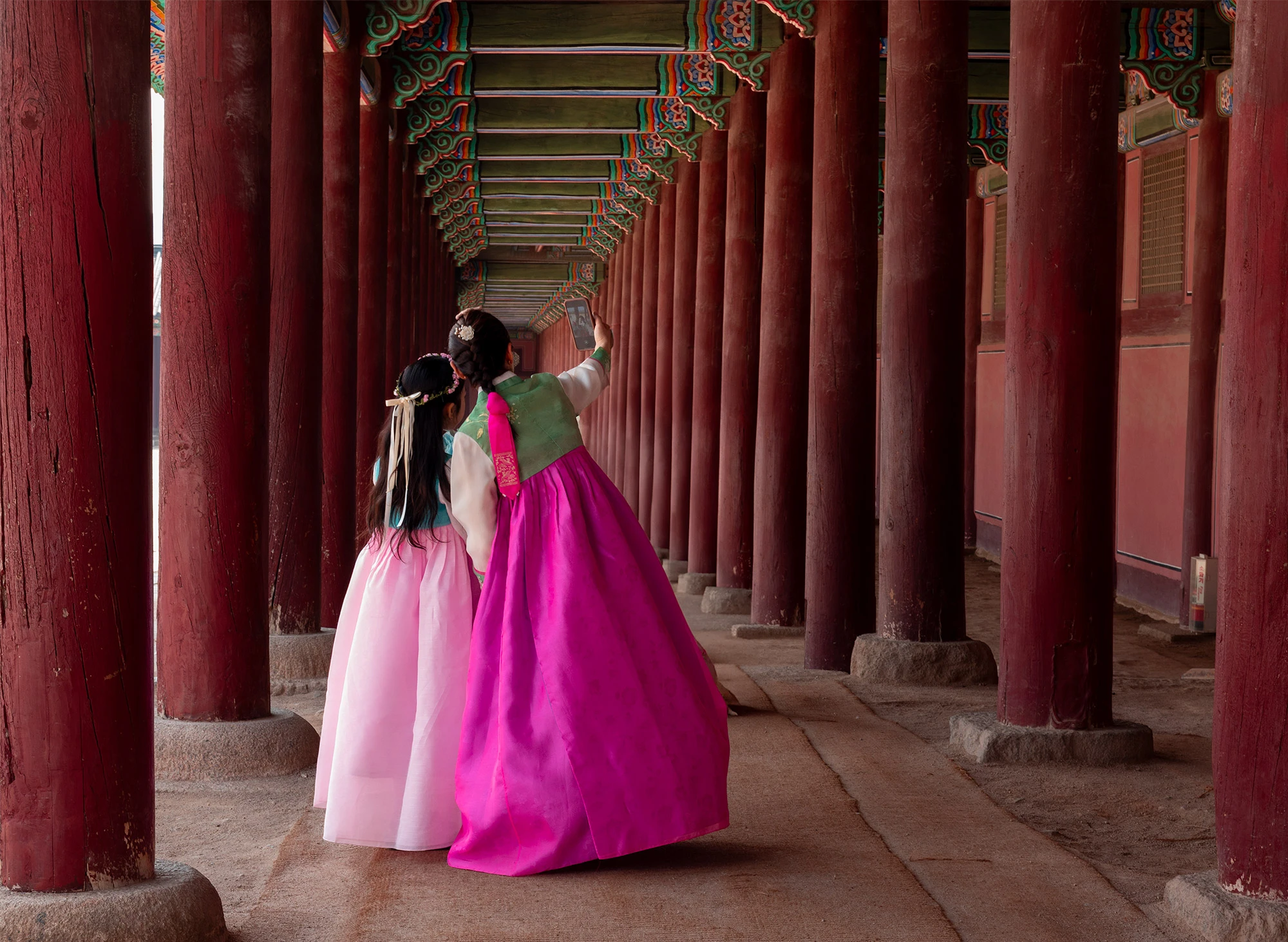
Dressed in traditional Korean hanbok, a mother and daughter take a selfie inside Gyeongbokgung Palace. Free entry is granted to visitors in hanbok, and thousands of Koreans and tourists take up the offer.
Crowd Control
R
Rain begins to fall, and I hail a cab. The streets that lead back to our rental are lined with full-sized buses, each parked three inches apart. They create an impenetrable barrier between the sidewalks and the road. Buses turned into battlements—soft-skinned tanks for crowd control.
But at the intersections, you can see the protesters. All of them are older than sixty. And rather than defiant, they appear subdued—more congregation than crowd—chanting an ear-splitting jingle. Their flags flutter more than their fists.
But wait, flags?
“Why are they holding American flags?” I ask the driver, feeling something deeply unsettling.
At first, he misdirects my question and says, “It’s idiotic. All they are doing is creating traffic.”
“They don’t look like they’re protesting against the President?” I say, staring at the sea of demonstrators.
Before he can answer, I see something else. They are holding English-language signs that say, “STOP THE STEAL”—the same false flag of voter fraud waved by American MAGAs to justify storming the U.S. Capitol and the attempted assassination of the Vice President.
Then, I see it. “They’re wearing RED HATS!”
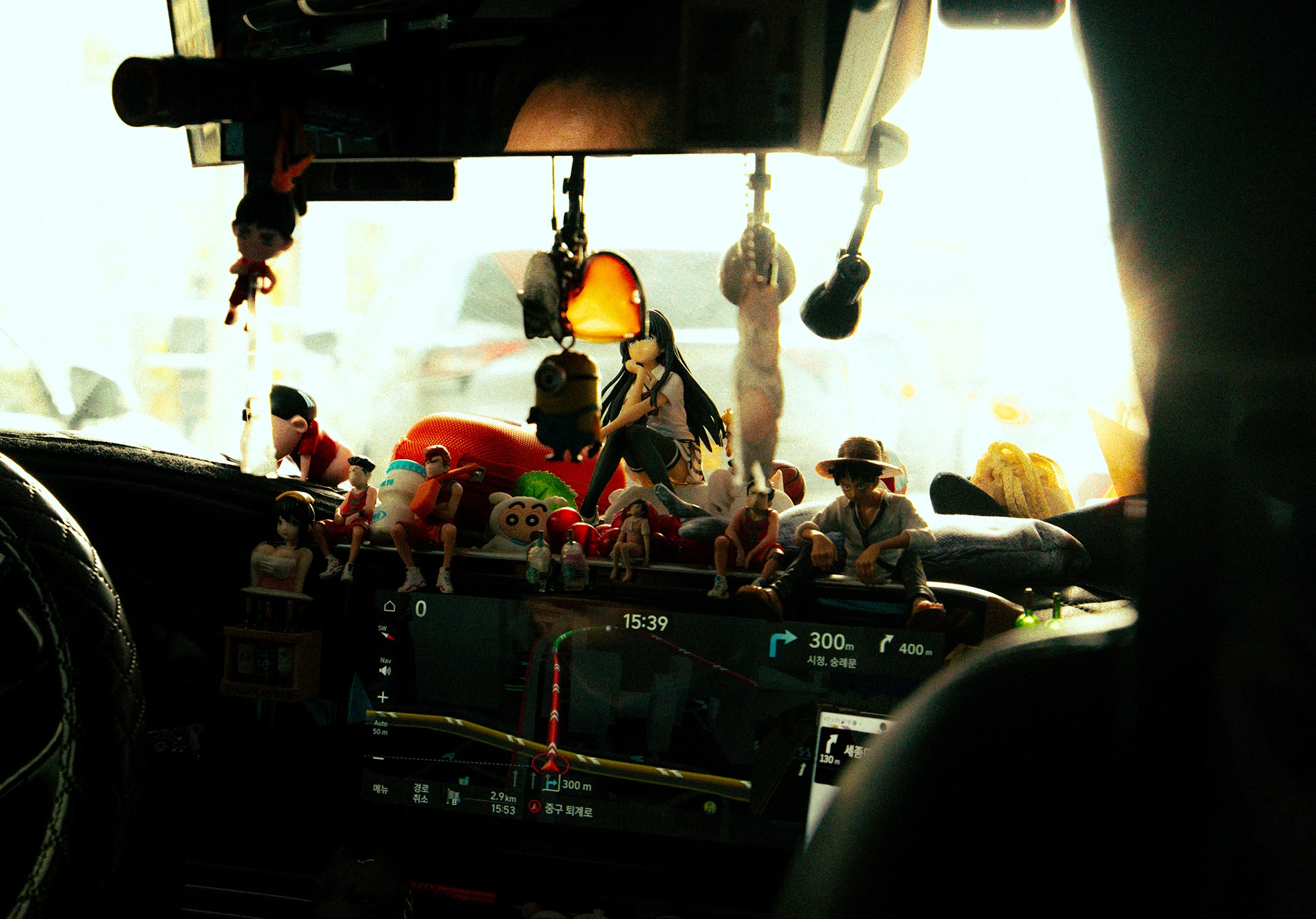
A taxi is Seoul with dashboard Anime figurines.
I
t is only now that it all starts to fit together. President Yoon Suk Yeol is an authoritarian whose public actions are eerily similar.
Yoon removed heads of public broadcasters, echoing Trump’s second-term purge of disloyal media executives. He moved to dismantle the free press, just like Trump targeted critical news outlets through FCC rollbacks. He weaponized prosecutors to investigate political enemies, mirroring Trump’s DOJ playbook. He pressured courts through partisan appointments, weakening judicial independence like Trump’s second-term court stacking. He branded dissenters and protesters as enemies of the state, echoing Trump’s labeling of opposition as “domestic terrorists.”
Yoon shielded his allies from corruption probes, just as Trump shields his dim loyalists with pardons and legal favors. He used riot police to crush labor strikes, paralleling Trump’s militarized ICE response to civil unrest.
Yoon leveraged defamation laws to silence journalists, as Trump threatens libel law reforms to punish the press. He framed all resistance as threats to national security, mirroring Trump’s rhetoric around “law and order.”
Yoon accused critics of being “pro–North Korea,” paralleling Trump’s branding of his opponents as un-American. He practiced selective law enforcement—prosecution for enemies, protection for friends—just like Trump.
He pushed for reforms concentrating executive power, just like Trump’s “unitary executive” ambitions. He revived conspiracies about the prior administration, echoing Trump’s endless Obama-era scapegoating. He appointed party loyalists to watchdog roles, as Trump populates the civil service with MAGA operatives.
Yoon publicly insulted and discredited journalists, following Trump’s “enemy of the people” mantra. He targeted satirists and cartoonists, echoing Trump’s obsession with controlling his image and trying to crush parody. He rolled back environmental protections, as Trump dismantled climate policy under the guise of “energy dominance.” He exploited national security fears to justify crackdowns, just like Trump’s use of border threats and terrorism hype. He undermined whistleblower protections, following Trump’s retaliation against truth-tellers.
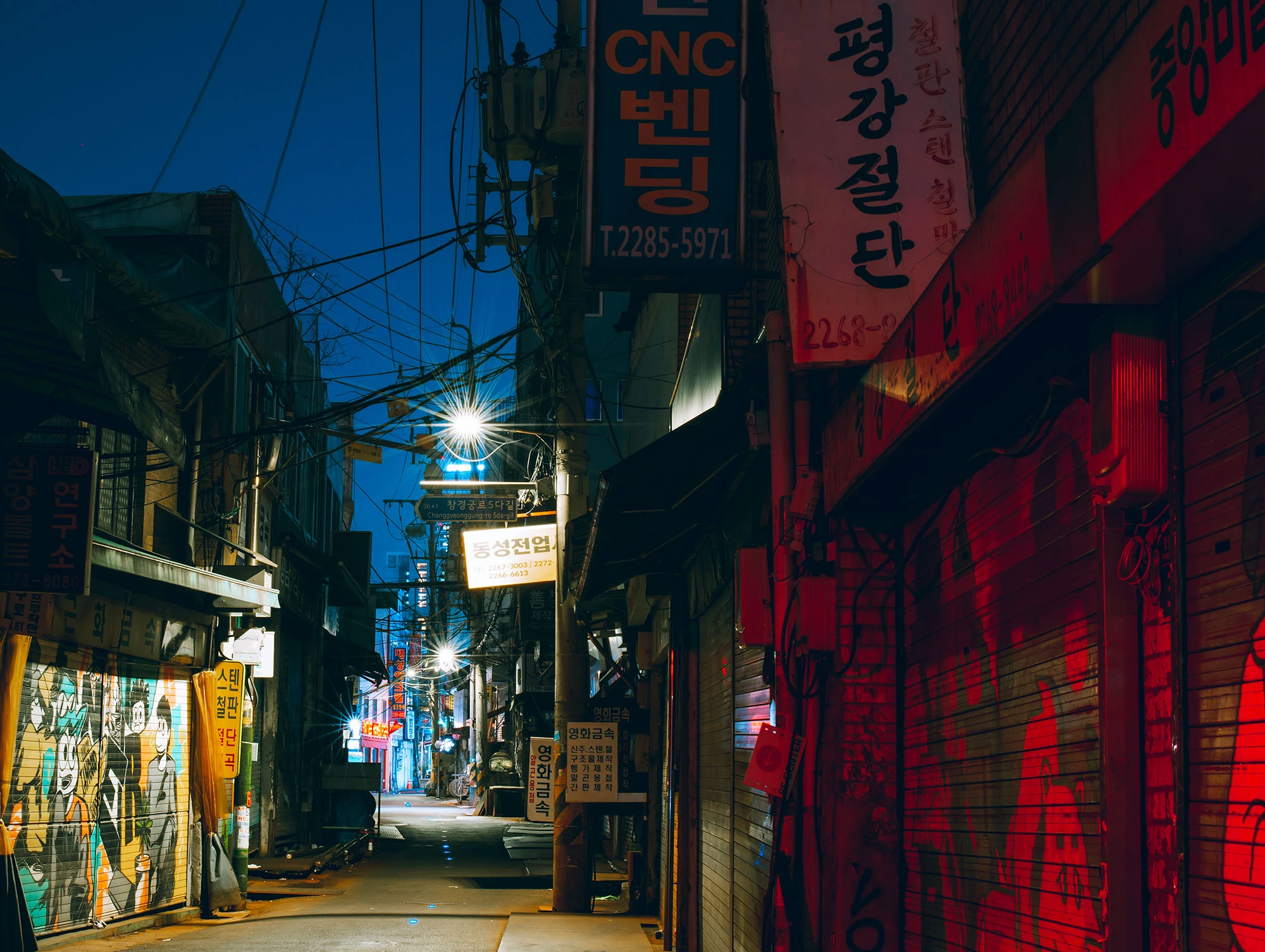
A lonely alley at the edge of the Euljiro neighborhood.
H
e turned government agencies into tools of personal and political warfare, in lockstep with Trump’s second-term authoritarianism. And he aligned closely with far-right evangelical groups, just as Trump courts religious extremists for political gain.
When Yoon called for nationwide Martial Law, he justified it by saying that everybody working against him was in cahoots with North Korea—of course, complete nonsense without a shred of evidence.
But does it sound familiar?
Of course.
But why? I grew up with this belief that the engines of progress and democracy were unstoppable. How did we get here, on the precipice of dystopia?
It’s easy to look at Yoon and say: This man is just a cheap imitator of Trump. But some of the most vile dictators around the world are unlikely to have been directly inspired by Trump. There was Duterte, who murdered innocent people in his drug wars, and Bolsonaro, who—parroting Trump’s Capitol riot—stormed government buildings in Brasília.
In the United States, people who oppose Trump are dead set in their daily hatred for everything he does and says, which is, of course, all good. But what if the world was having a fever dream, and instead of an onslaught of endless Trump memes, in this dream, the world asked: Is it possible that Yoon, and Duterte, and Bolsonaro, and Trump are not the cause—but rather the symptom?
If they are the symptom, we must know the cause. It may be one of the most important questions humankind ever asks—before it's too late.
Is it charismatic leader syndrome? The lure of populist tribalism? Democratic fatigue? Or is it Rupert Murdoch squatting over the English-language countries with his Foxhole fumes? Perhaps, it’s the decay of centrist media narratives altogether?
Whatever it is, it’s important to ask why the checks and balances worked in the end in the Philippines, Brazil, and—within three days—here in South Korea, when the Constitutional Court unanimously upheld Yoon’s impeachment.
But not at home.
The driver drops me off, and I return to our rental, where classical music is playing from the toilet.
But then Jane explains that the recurring classical music is not our toilet at all. A tile worker is laboring away next door, right on the other side of the bathroom wall, playing classical music all night on a small radio.
Forgive me, Toto-bot.
